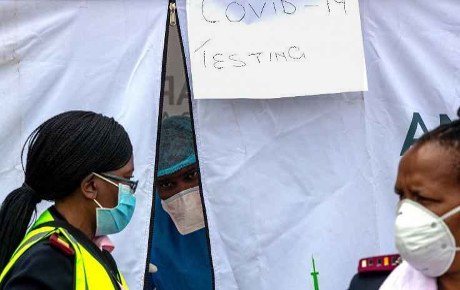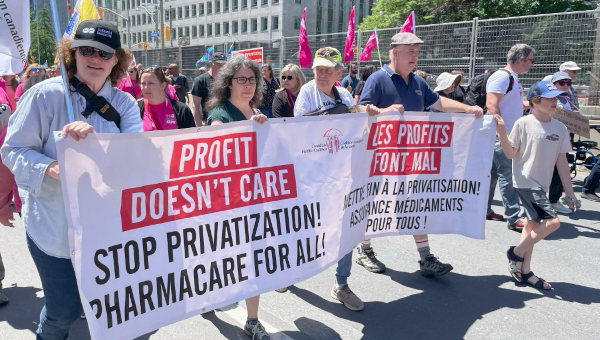Covid-19 Unmasks Dangers of Commodified Healthcare
Covid-19 has been linked to a number of truth claims long made by activists in South Africa and around the world. Perhaps most glaring is the need for universal healthcare and fortified public healthcare.

Following the mid-March announcements of measures to deal with the pandemic and the global financial crisis, researcher Sameer Dossani argued that while universal basic income and other income supports would help boost flagging economies, Covid-19 reveals universal healthcare as the most important need.
More recently, researcher and writer David Hemson draws attention to the 4,960 critical care beds in South Africa’s private sector versus the 2,240 ones in the public sector. Hemson underlines that one of the most pressing questions is how the private beds will be used equitably as Covid-19 spreads to the uninsured majority in the face of conflicting claims from the minority with medical insurance.
Brought to the surface by the current pandemic, these issues beg for unity through a common analysis and popular mobilisation in terms of solutions. For advocates and activists from a wide spectrum of political views – Sibongiseni Dhlomo, Shehnaz Munshi and Oupa Lehulere, to mention a few – National Health Insurance (NHI) is the solution for South Africa.
Deeper analysis that draws on medicines being used to treat the pandemic and decades of public healthcare experience in other countries, however, brings out the fundamentally flawed model of the NHI. The analysis is also relevant for other African countries in which public health insurance similar to the NHI is being designed and discussed.
Cuba and Medicines
Interferon Alfa 2B is one of 22 medicines that Cuba is producing to treat Covid-19 internationally and a major antiviral used in China from the onset of the pandemic. The story of how the antiviral came into being helps paint a picture of people-oriented, decommodified public healthcare that stands in contrast to the proposed NHI.
Interferons are proteins produced and released by cells in response to infections. The release, in turn, prompts other cells to heighten their antiviral defences. Cuba began investing in interferons in the 1970s. Interferon Alfa 2B is a product of one of Cuba’s 31 state-owned pharmaceutical firms, which fall under the umbrella agency BioCubaFarma. These firms research and produce drugs and vaccines as per the healthcare needs of the majority in Cuba.
Developed to crush the Dengue virus outbreak in Cuba in 1981, Interferon Alfa 2B was successful and has since been used to fight hepatitis B and C, shingles, HIV and Aids in Cuba and elsewhere.
Like its use, the origins of Interferon Alfa 2B is also multinational. As economic and social history lecturer Helen Yaffe explains in a London School of Economics blog, interferons were first identified by London-based researchers in 1957. By the 1970s, United States oncologist Randolph Clark Lee shared successive work with Cubans during then-president Jimmy Carter’s easing of the US embargo on Cuba. Fidel Castro saw the promise of interferons for curbing infectious diseases typical in countries like Cuba.
By September 1981, having learned from Finnish doctors how to isolate human interferon and produce it en masse, Cubans created Interferon Alfa 2B to treat Dengue fever, which affected 344,203 people in 1981. Due to the success of the antiviral, only 158 deaths resulted from the outbreak.
Multinational as it is, Interferon Alfa 2B could not have been a project for the multinational pharmaceutical industry. This is because such a drug cannot realise the level of profit required by pharmaceutical corporations. Johnson & Johnson’s profit, for example, rose 1,077% between 2018 and 2019, despite more than 13,000 lawsuits concerning ovarian and lung cancers linked to the company’s famous baby powder. Looking further back and calculating from Fortune 500 annual figures, Johnson & Johnson has had average annual profit increases of 201% since 2015.
Beyond antivirals, Interferon Alfa 2B is one of 569 medicines produced in Cuba. This is two thirds of the 857 medicines approved for use in the Cuban health system. Comprising about 21,000 workers, including 6,158 university graduates – 270 with Ph.D.s and more than 1,000 with master’s degrees – BioCubaFarma also contributes to foreign exchange generation. As of 2015, Cuban pharmaceutical and biotechnology products were exported to 49 countries. This includes China, which has a joint venture with Cuba to produce Interferon Alfa 2B and was the first country to add it to the list of medicines to treat Covid-19.
Implications for Africa
The lesson here for South Africa and other African countries is simple. For a continent that is struggling to strengthen public healthcare and suffering from poor population health as well as high unemployment, a people-oriented, decommodified model like Cuba’s can turn healthcare into a means of transformation.

The production of health goods that prioritises the needs of the majority – and trains and employs local people in the process – helps strengthen population health while keeping costs down. It also avoids the draining of resources and lives as in the Johnson & Johnson case of soaring profits and destructive products. In addition, healthcare production driven by the needs of the majority creates the potential for exports that spread yet greater good.
In South Africa, this could take shape by socialising the private healthcare industry, which the government’s own health market inquiry has found is controlled by just four mega-corporations: Remgro, AfroCentric Investment Corporation, the Life Healthcare Group and Netcare. They own and control a number of sub-sectors that range from pharmaceutical production, pharmacies, hospitals and homes for the ill and elderly to medical scheme administration and managed care.
The monopoly of these four corporations has evolved largely after 1994 and, like many other aspects of the post-apartheid economy, is a problem that can be rectified now for the benefit of the majority. If activists mobilise around socialising the private health industry, it would be a people-centred solution for the long term, far beyond temporary solutions such as the nationalisation of healthcare industries in Spain and Italy to tackle Covid-19.
This contrasts sharply with the private health industry-dependent model of the NHI, which amplifies the current organisation of public healthcare in which the state subcontracts to private firms. As is well known in South Africa and has been documented for several European countries which have divided public healthcare between the state as funder and private firms as care providers since the 1980s, the major results are under-delivery of goods and services and wastage of public funds through overpricing, corruption and patronage.
Socialised, decommodified universal healthcare also contrasts with models of public healthcare like Canada’s, where delivery of hospital care is fully public but dependent on privately produced pharmaceuticals and medical equipment. Over the past 50 years, this dependence has meant that an increasing proportion of public funds has gone to pharmaceutical and medical equipment firms like Johnson & Johnson, while hospital funding has fallen to a bare minimum. Clearly this is not the model of universal healthcare that can take on epidemics and pandemics the way Cuba’s system has and continues to do.
As Covid-19 relief packages in many countries suggest, the risk of neoliberal solutions is high, with the largest share of benefits going to big employers, banks and other corporations rather than workers, the underemployed and the unemployed. Health systems are also at risk of being shaped and reshaped along neoliberal capitalist lines – unless activists seize the moment. The fast spread and multiple impacts of Covid-19 make the demand for decommodified, fully non-profit, people-driven universal public healthcare the basis from which to begin rebuilding society in South Africa and beyond. •
This article was first published by New Frame.





